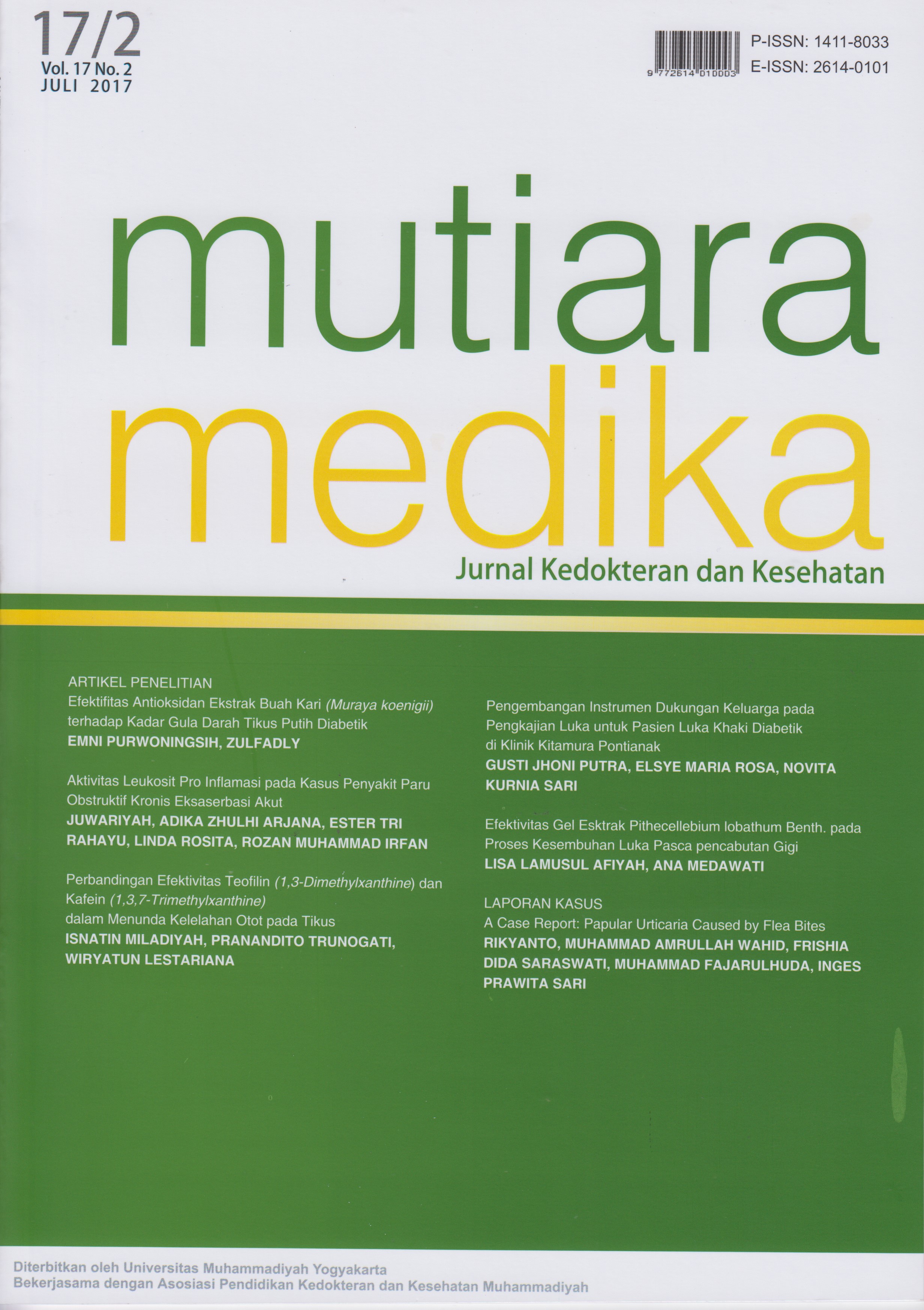Efektifitas Antioksidan Ekstrak Buah Kari (Muraya koenigii) terhadap Kadar Gula Darah Tikus Putih Diabetic
DOI:
https://doi.org/10.18196/mm.170201Keywords:
Diabetes mellitus, Buah kari, StreptozotosinAbstract
Diabetes Militus adalah penyakit metabolisme yang berhubungan dengan gaya hidup dan tingkat stress dengan mengkonsumsi makanan yang tidak sehat, dan kurang berolahraga, serta lingkungan yang berpolusi. Radikal bebas yang sangat reaktif dan tidak stabil di dalam tubuh dapat menyebabkan kerusakan seluler, jaringan dan mutasi gen. daun Kari memiliki konsentrasi antioksidan tertinggi sebesar 322,51 ppm dengan temperature ekstraksi 70. Penelitian ini adalah true experimental pre and post with control group design. Hasil penelitian yang diperoleh adalah ada perbedaan kadar gula darah pada kelompok pre test dan posttest tidak ada perbedaan. Kesimpulan penelitian ini bahwa pemberian ekstrak buah kari pada tikus putih jantan yang diinduksi streptozotosin tidak menurunkan kadar gula darah secara signifikan pada berbagai kelompok perlakuan.References
World Health Organization. Global health estimates: deaths by cause, age, sex and country, 2000-2012. Geneva, WHO; 2014.
Sedyaningsih ER. Diabetes penyebab kematian terbesar ketiga di indonesia. 2011. Available from : http://kesehatanutama.weebly.com/. Di akses : 17 Januari 2012.
Riskesdas. Prevalensi diabetes mellitus. Badan Penelitia dan Pengembangan Kementerian Kesehatan RI. 2013: 87-90.
Definition, diagnosis and classification of diabetes mellitus and its complications. Part 1: Diagnosis and classification of diabetes mellitus. Geneva, World Health Organization, 1999 (WHO/NCD/NCS/99.2).
Lim, H. Obat-obat yang digunakan untuk hiperglikemua. Dalam buku prinsip farmakologi-endokrin-infeksi. Edisi 1. Softmedia. 2014: 101-10.
Choudhory PR, AN Grag. Variation in essential, trace, and toxic elemental contents in murraya koenigii a spice and medicinal herb from different indian states. J Food chem. 2007; 104:1454-63.
Khanum F, Anilakumar KR, Sudarshana KR, Viswanathan KR, Santhanam K. Anticarcinogenic effect of curry leaves in dimenthylhydrazine-treated rats. J Plan Food Human Nutrition 55. 2000; 347-55.
Ningappa MB, Dhanajaya BL, Dinesha R, Harsha R, Srinivas L. Antioksidant and free radical scavenging activities of polyphenol-enriched curry leaf (murraya koenigii l.) Extract. Food chem. 2008; 106(2): 720-28.
Tembhurne SV, Sakarkhar DM. Hypoglycemia effeects of fruits juice of murraya koenigii (l) in alloxan induced diabetic mice. International Journal of PharmTech Research. 2009; Vol.1, No.4: 1589-93.
Arulselvan P, Subiramanian. Effect of murraya koenigii leaf extract on carbohydrate metabolism studied streptozotocin induced diabetic rats. International journal of biological chemistry. 2007: 21-28.
Kesari AN, Kesari S, Singh SK, Gupta RK, Watal G. Studies on the glycemic and lipidemic effect of murraya koenigii in experimental animals. Journal of Ethnopharmacology. 2007; 112: 305–11.
Lawal HA, Atiku MK, Khelpai DG, Wannang MM. Hypoglycaemic and hypolipidaemic effects of the aqueous leaf extract of murraya koenigii in normal and alloxan–diabetic rats. Nigerian Journal of Physiological Sciences. 2008; 23 (1-2): 37-40.
Dineshkumar B, Mitra A, Mahadevappa M. Antidiabetic and hypolipidemic effects of mahanimbine (carbazole alkaloid) from murraya koenigii (rutaceae) leaves. International Journal of Phytomedicine. 2012; 2: 22-30.
Jafri SA, Rehman KU, Qasim M, Kalsoom. Effect of murraya koenigii, catharanthus roseus and psidium guajava leaves extract on blood glucose in alloxan induced diabetic rats. American Journal of Biology and Life Sciences. 2014; 2(1): 1-5.
Tembhurne SV, Sakarkar DM. Influence of murraya koenigii on experimental model of diabetes and progression of neuropathic pain. Res Pharm Sci. 2010 Jan-Jun; 5(1): 41–47.
Srinivasan K, Ramarao P. Animal models in type 2 diabetes research. Indian J Med Res; 2007.
Dahlan MS. Uji repeated anova. Dalam buku statistik untuk kedokteran dan kesehatan. Salemba medika. 2011: 114.
Amin ME, et al. 2013. Anti-diabetic effect of murraya koenigii (l) and olea europea (l) leaf extracts on streptozotocin induced diabetic rats. Pak. J. Pharm. Sci. March 2013; Vol.26, No.2: 359-65.
Waghmare AN, Tembhurne SV, Sakarkar DM. Phytochemical analysis and in vitro antioxidant properties of murraya koenigii (l.) fruits. American Journal of Phytomedicine and Clinical Therapeutics. 2015: 2321-748.
Kesari AN, Gupta RK, Watal G. Hypoglycemic effects of murraya koenigii on normal and alloxan-diabetic rabbits. J. Ethnopharmacol. 2005; 97 : 247-51.
Downloads
Published
Issue
Section
License
Copyright
Authors retain copyright and grant Mutiara Medika: Jurnal Kedokteran dan Kesehatan (MMJKK) the right of first publication with the work simultaneously licensed under an Attribution 4.0 International (CC BY 4.0) that allows others to remix, adapt and build upon the work with an acknowledgment of the work's authorship and of the initial publication in Mutiara Medika: Jurnal Kedokteran dan Kesehatan (MMJKK).
Authors are permitted to copy and redistribute the journal's published version of the work (e.g., post it to an institutional repository or publish it in a book), with an acknowledgment of its initial publication in Mutiara Medika: Jurnal Kedokteran dan Kesehatan (MMJKK).
License
Articles published in the Mutiara Medika: Jurnal Kedokteran dan Kesehatan (MMJKK) are licensed under an Attribution 4.0 International (CC BY 4.0) license. You are free to:
- Share — copy and redistribute the material in any medium or format.
- Adapt — remix, transform, and build upon the material for any purpose, even commercially.
This license is acceptable for Free Cultural Works. The licensor cannot revoke these freedoms as long as you follow the license terms. Under the following terms:
Attribution — You must give appropriate credit, provide a link to the license, and indicate if changes were made. You may do so in any reasonable manner, but not in any way that suggests the licensor endorses you or your use.
- No additional restrictions — You may not apply legal terms or technological measures that legally restrict others from doing anything the license permits.






